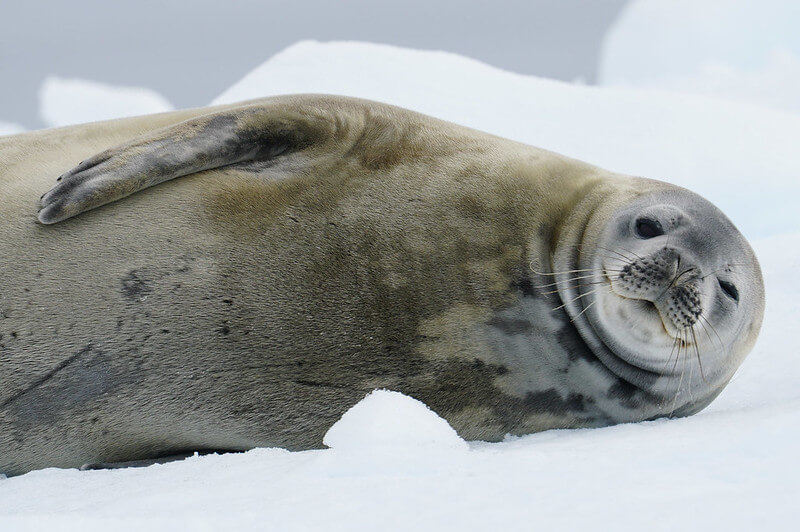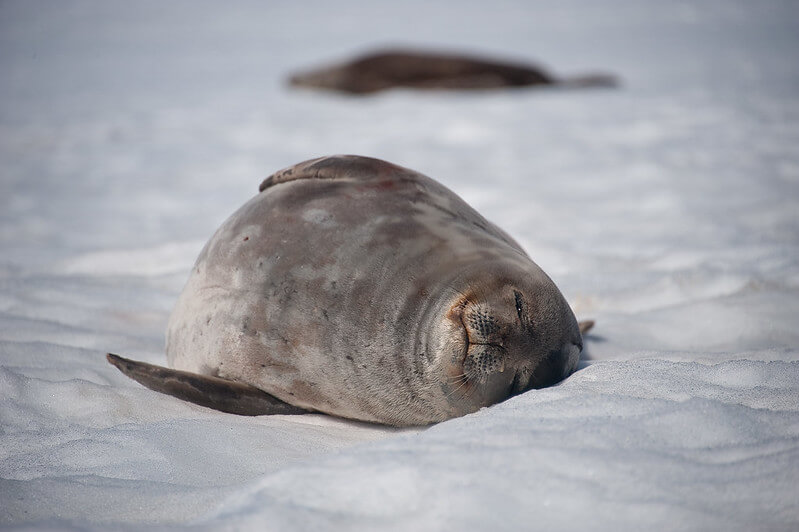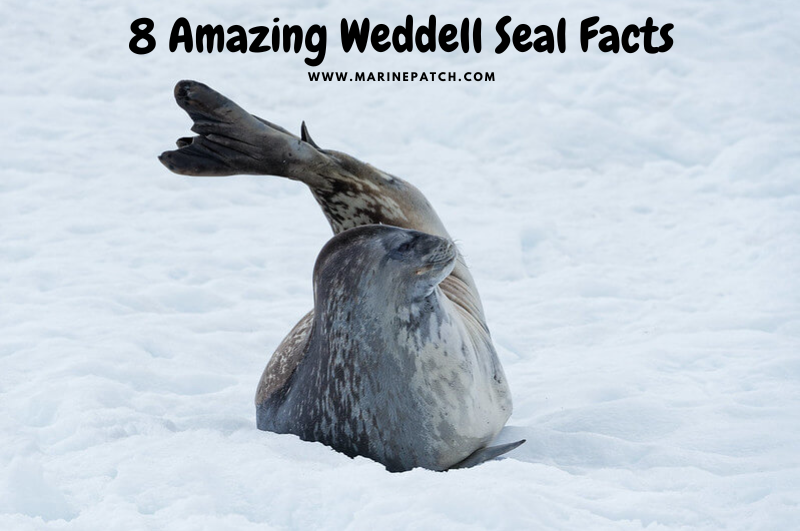The Wedell seal is found in large numbers in the Antarctic region and thanks to its abundance and large size its been one of the most widely studied Antarctic seal species.
Their pups are also some of the most photogenic and chances are you have seen pictures of these adorable fur balls multiple times.
However, there is a lot more to this marine mammal than cute babies and for that reason today I bring you 8 amazing Weddell seal facts for your enjoyment.
1. Weddell Seals Have The Southernmost Range Of Any Mammal
The Weddell seal is found living further south than any other seal, or mammal.
This feat can be accomplished thanks to this seal’s behavior of creating its own breathing holes in the Antarctic ice pack.
While the Wedell seal spends most of its life underwater and can hold its breath for up to 80 minutes while diving, it’s important to remember that this animal is a mammal after all and coming up for breaths every once in a while is absolutely mandatory.
Since this seal swims such large distances on a single breath it may find itself too far from a known breathing hole or ice crack when it’s time to take a breather.
In this scenario the Weddell seal will use its teeth, rasping them back and forth on the ice pack, to create a hole.
However, this behavior comes with a cost and Weddell seals inhabiting areas that require constant ice grinding have a reduced life expectancy as this behavior wears down their teeth significantly.
2. Weddell Seals Are Really Good Divers
Besides holding its breath for a really long time the Weddell seal is also an amazing diver reaching depths of around 600 m / 1,969 feet.
Just to give you an idea of how ridiculously deep that is the tallest building in the entire United States is the ONE WORLD TRADE CENTER which reaches 541 m / 1,775 ft. at its highest point.

When diving, the Weddell seal consumes 1.5 times the amount of oxygen usually consumed when resting, which is a pretty low rate compared to how much more oxygen is used by other diving mammals and birds.
This is a key metabolic feature that allows this marine mammal to carry out such deep and long foraging dives.
3. Weddell Seals Are Very Big
Weddell seals are the fourth largest seal species in the world with females reaching 3.3 m / 10.7 ft. in length and a weight of around 500 kg / 1,100 lbs.
Males are a little smaller with a length of 2.9 m / 9.5 ft. and a weight of 450 kg / 990 lbs.
4. Weddell Seals Produce Very Rich Milk
The Weddell seal produces one of the richest milk in the animal kingdom as it is known to contain around 60% fat.
This is required for a newborn pup that must quickly gain enough weight to survive the extreme antarctic weather.
A Weddell seal pup weighs around 29 kg / 64 lbs. at birth, it will double its birth weight in just 10 days, and by the time it weans, at about six weeks of age, it will have quadrupled its birth weight.
So if a pup was born weighing 30 kg / 66 lbs it will be 120 kg / 265 lbs. in just 6 weeks.
5. Male Weddell Seals Hoard Breathing Holes
During birthing season, male Weddell seals will open, and maintain, breathing holes close to nursing mothers.
The male will then guard and defend the breathing hole territory right beneath the ice from other males allowing only females and their pups to use them.
This behavior, of course, doesn’t stem from the pure heart of a male Weddell seal, it is merely a way to successfully mate as females are ready to breed shortly after the pup is born, and by allowing them to use this spot it is expected of them to mate with him.
Each breathing hole will be used by about 10 females with their pups so the male-to-female ratio per hole is typically 1 / 10.
6. Weddell Seals Have No Land Predators
Thanks to their large size and to inhabiting such a hostile and remote place, an adult Weddell seal doesn’t have to worry about anyone eating it while resting on ice.
Killer whales are the only predator of this marine mammal. Leopard seals will occasionally hunt and eat pups and juveniles.
Humans used to hunt Weddell seals as they were the main food fed to sled dogs when these were present in Antarctica (from 1899 until 1994).
However, the Weddell seal population is abundant and considered “least concern” by the IUCN (International Union for the Conservation of Nature).
7. There is an Isolated Population Of Weddell Seals
There is a small population of Weddell seals that are trapped on White Island which is located even further south than the rest of its conspecifics.
This group of seals has the record of being the only mammals living so close to the south pole.
It is believed that the group of seals became trapped in White Island in the 1940s – 1950s when sea ice broke during the Antarctic summer.

Once the ice reformed it was too late for the individuals that were still on the island and they remain trapped between the Ross and McMurdo ice shelves.
To join the rest of the population on Erebus Bay the White island seals would have to swim for over 20 km / 12.4 miles under the thick ice cap which is too far of a swim for this species.
This population has been heavily studied and scientists have been able to gain valuable insight that can be extrapolated to help different species of threatened mammals around the world.
8. Weddell Seals Have Very Large Eyes
Even though the Weddell seal is a diurnal predator it can get pretty dark under the thick ice.
Also worth mentioning again is the fact that this seal hunts at an average depth of 100 – 350 m / 328 – 1,148 ft., even going as deep as 600 m / 1,969 ft. sometimes which can be pitch black even during the middle of the day.
The Weddell seal has special adaptations that allow it to successfully hunt prey in this lowlight waters such as very large eyes.
The average diameter of an adult Weddell seal eye is 50 mm which is about twice as large as a human eye. The larger the eye the more light it can take in.
Weddell seals also have a larger, rounder lens inside each eye which bends the light so that the retina can focus the image while submerged instead of seeing everything all distorted like you and I do when we open our eyes underwater.
I am a lover of everything nature and animal related with over 15 years of experience in the field of wildlife rescue and education. Currently living in Colombia working with wild and domestic animals and spending all my free time writing about them 🙂

